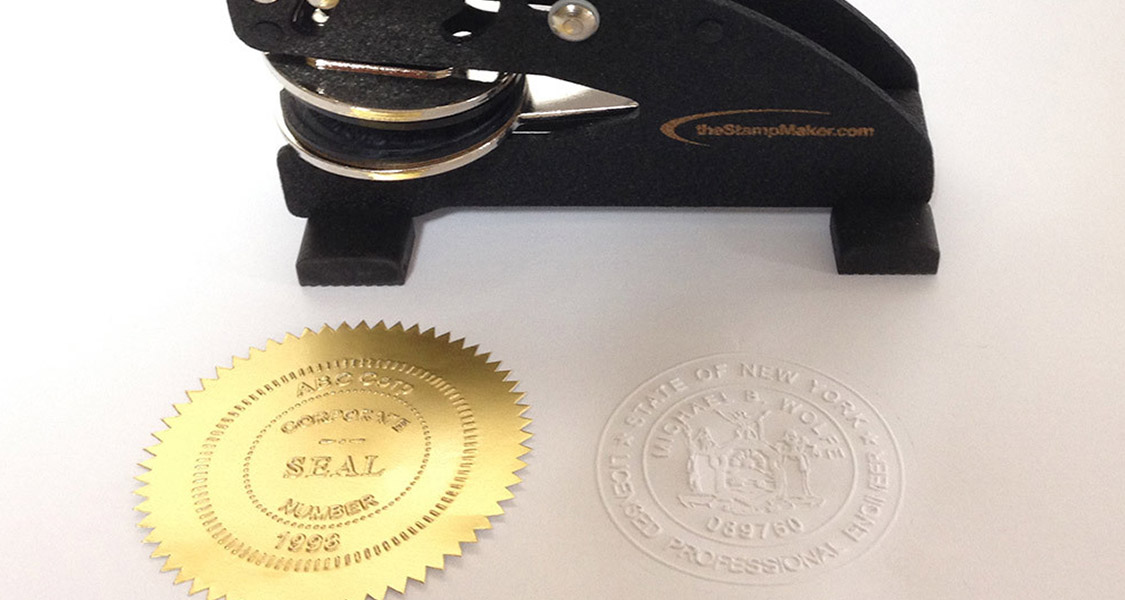What Exactly is Embossing?

Whether or not you knew the technical term for it, you have surely seen or felt an embossed pattern. For example, when you run your finger across a seal and find that the pattern is raised against the paper, that effect is achieved through embossing. It can be employed on a variety of materials for a variety of purposes.
Embossed patterns can be tailored to anyone—whether you need a professional seal for your business or a personal one with customized artwork, embossing is easily applicable. Here we’re going through what exactly embossing is, how it’s done, and how it can be used.
Embossing Origins
Embossing can be traced back roughly to the 15th century when heated stamping plates were used to create stationery for high-end purposes. By the 19th century, embossing services were both more affordable and accessible. Embossing techniques were mostly used to make coins.
As time has gone on, the possibilities of embossing have only expanded; they are used on documents, and stationery. Today, there are many different approaches to achieve the embossed effect on paper, and they all have their advantages and disadvantages.
Different Techniques Used for Embossing
Not all embossing techniques are the same, and it is important to note the differences in order to determine which is right for you.
Dry Embossing
This is one of the simplest techniques, using a specialized stylus to trace a stencil onto a piece of paper. The result is a minimalistic and professional raised image that blends in seamlessly with the material.
Heat Embossing
This is different from the “regular” embossing process in that it works with a design that’s pre-stamped with embossing ink. Embossing powders are added to the image and heated, which in turn creates an embossed effect on a glossy, colorful pattern.
Embossing Paste
This technique requires the user to apply a special paste onto paper with the help of a stencil. When the paste dries, the finalized product is an embossed image.
Other Design Techniques
Note, however, that die-cutting and debossing are not embossing techniques. Die-cutting, rather than creating a three-dimensional embossed image, cuts shapes out of material. The process uses die, steel blades designed for die-cutting. Debossing, alternatively, is the complement to embossing. Debossing does not create a raised image, but an indented one that inverts into the material.
Commonly used embossers use a variation of dry embossing. The device is made with two die plates, one with an embossed image and one with a debossed image. By applying pressure, the die plates come together, contact the material, and leave behind a raised image. These can be used for foil stamping or paper embossing.
How Can I Use Embossers?
The potential applications of embossing are vast. These are some of the most practical uses for paper embossing:
- Corporate Seals. Use these seals to verify your business documents. This works well with foil embossing.
- Notary Seals. Notary embossers are personalized by state and personal information, and they abide by state regulations.
- Engineer Seals. Engineer embossers are also specific to state regulations and certify that you are a professional registered engineer.
- Architect Seals. Customizable seals for architectural documents, specific to your state of work, validate your work.
- Personalized Embossers. You can customize an embosser for any other purpose. Whether you want to personalize a seal for your business or simply create a decorative design you can easily imprint, embosser design is flexible.
Embossed designs are crucial for document verification and professionalism, but they are also a longstanding form of art. No matter the application, embossing will validate your personal brand and elevate any material you use it on.